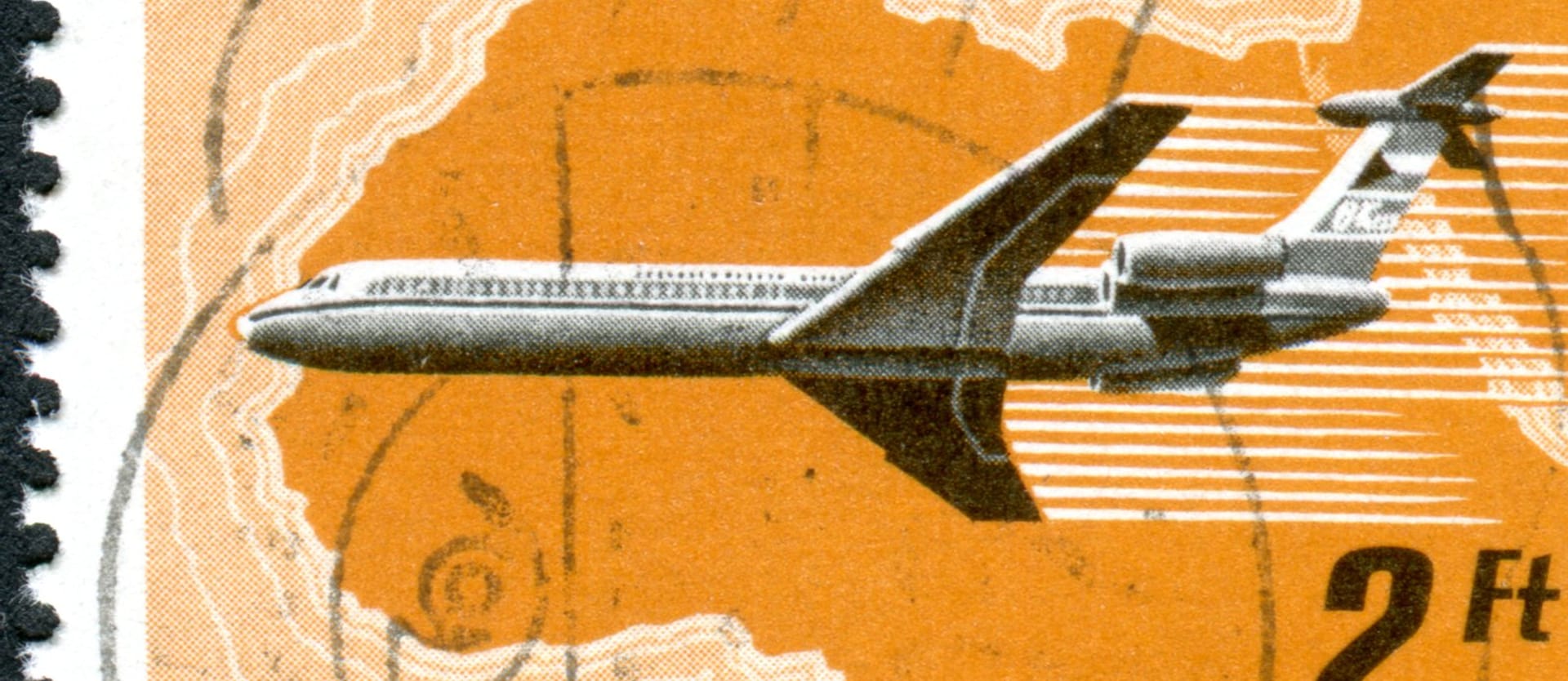It happens every time travelers book a flight. No matter whether they eventually buy tickets and board a plane or cancel the reservation and stay home, the deed is done. Data on them has been collected and saved in the form of a passenger name record or PNR.
Introduced to facilitate the exchange of booking information between airlines, PNRs have become an important component of the travel industry. They act as booking confirmation, a repository of valuable commercial information, and even a weapon against global terrorism.
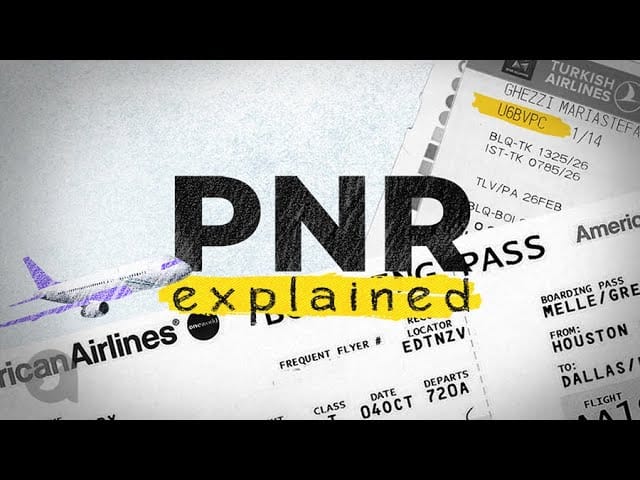

Make sure to check out our video on PNR if you’re more of a visual type
This article describes the important technical and legal aspects of PNR creation and usage. It takes a close look at its content, touches on some privacy concerns, and peeks into the future of travel records.
But first, let’s cover the basics.
What is the meaning of PNR?
PNR stands for passenger name record. It’s a digital document containing the itinerary, passenger details, payment information, etc.
The essential components of a PNR include:
- phone number,
- details of the last person who made changes to the PNR (usually the passenger or travel agent),
- itinerary details,
- passenger names, and
- ticketing information.
Optional elements may include:
- additional itinerary segments (such as other flights, hotel bookings, or car rentals),
- payment details,
- credit card information,
- passenger email addresses,
- frequent flyer numbers, and more.
Most passengers never interact with a PNR itself but often use a PNR number—a 6-digit alphanumeric code assigned to the PNR file upon its creation.
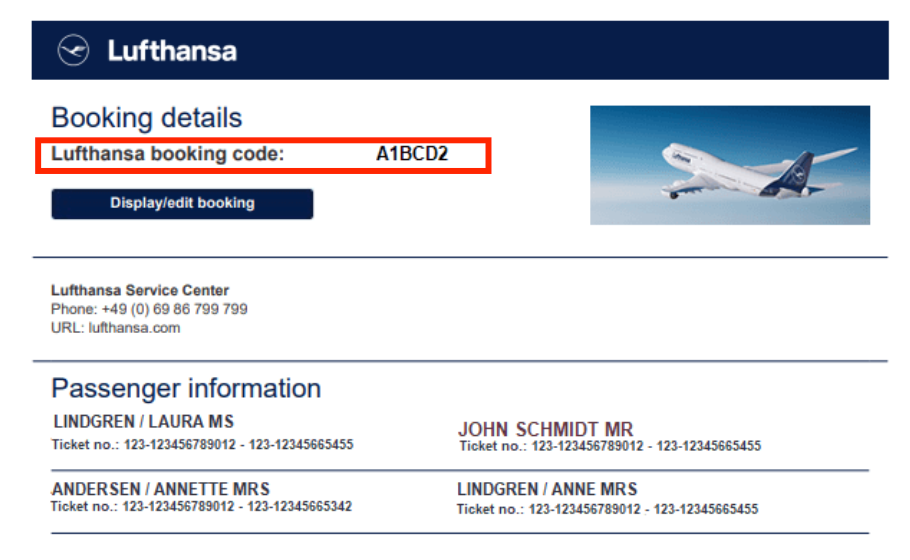
An example of a PNR code found in a booking confirmation email from Lufthansa. Source: Refundmore
A PNR code is commonly found on a booking confirmation emailed to passengers after reservation, also on e-tickets and boarding passes. There, it can be called a record locator, booking reference, reservation code, or just PNR. Passengers can use it to access their flight details or check in on the airline’s website, but not the PNR file itself.
Though PNR codes look like random mixtures of characters, in fact, airlines apply special algorithms to place the letters and numbers in a certain sequence and avoid duplicating already existing combinations. When generating references, carriers also strive to recognize and censor profanity. Codes can be repeated, but only long after the trip under the same PNR is completed.
What are PNR examples in a flight ticket?
It’s easy to distinguish the PNR code from the flight number or other codes found on the confirmation emails or e-tickets. It’s a 6-digit code, typically containing letters or made up of letters only. How can it manifest itself?
Here’s an example of the booking confirmation document issued by LOT, where a PNR code is called a booking reference.
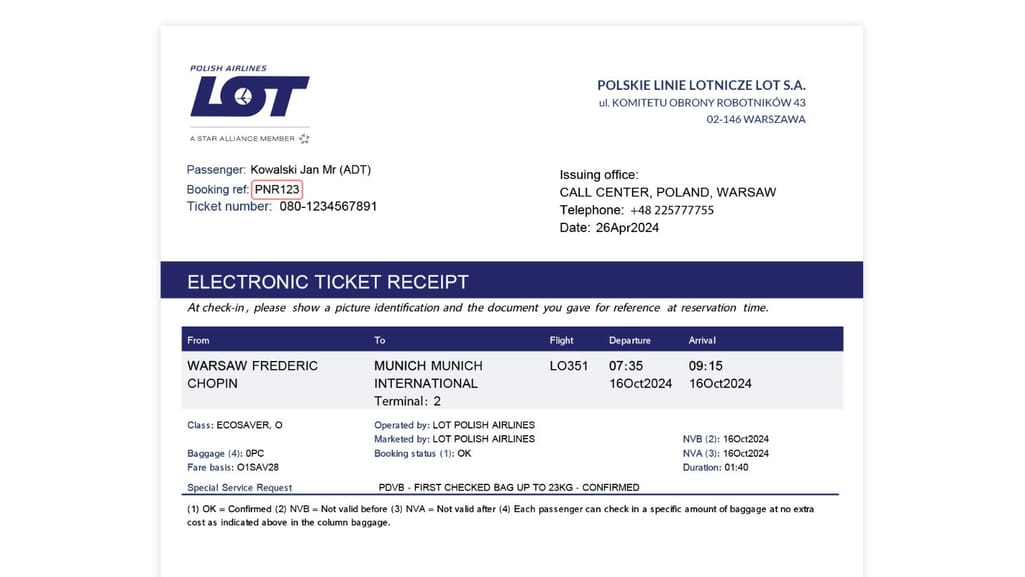
Source: LOT
In the screenshot below, you can see the flight details provided by the travel agency Sunweb, where PNR code is stated too.

Source: Sunweb
Finally, here’s an email sent to a passenger by Frontier Airlines, where a PNR number is called a flight confirmation code.
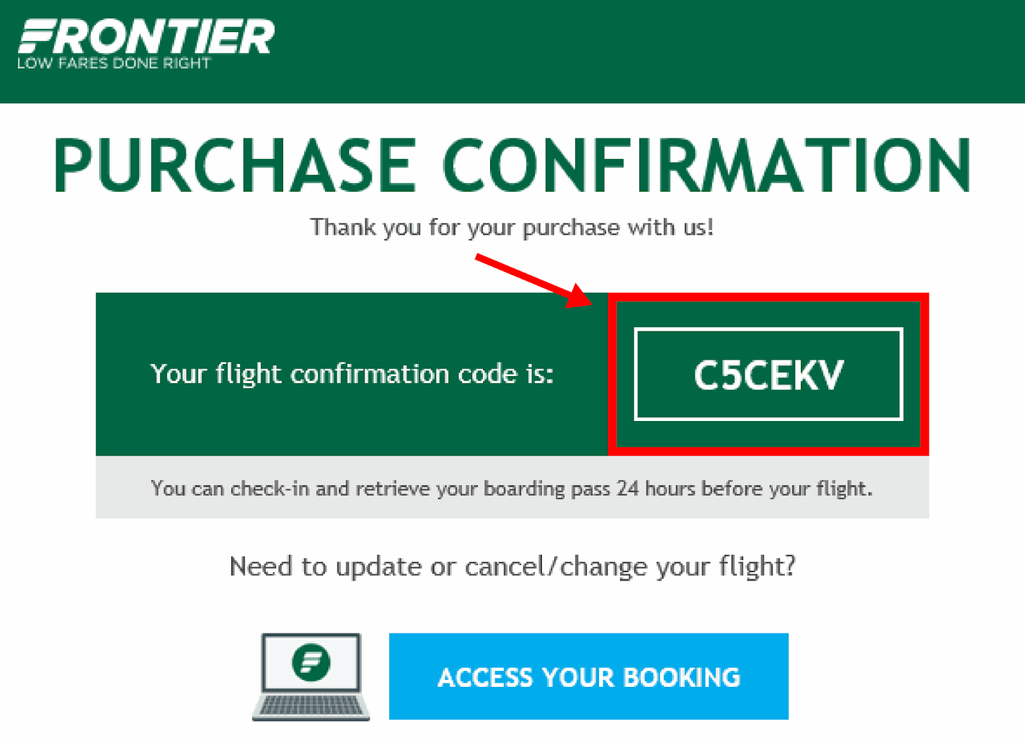
Source: Frontier
Is PNR the same as booking number, booking reference, confirmation number, etc?
It’s worth repeating that PNR itself is not a number but a record with passenger data. A number with reference to the PNR file can have different names, such as
- PNR code/number,
- record locator,
- booking reference
- confirmation number,
- reservation number,
- booking code,
- travel itinerary reference,
- airline reference code, and many more.
However, sometimes sellers will use the terms PNR and PNR code interchangeably in traveler documents for convenience.
What is the PNR number on bus and train tickets?
Although the PNR and its code originated in the airline industry, the same term can sometimes be used for rail and even bus ticket booking.
For example, French railway operator SNCF also issues a PNR number, found under the name Dossier Voyage (Travel Number) and can contain 6 to 8 alphanumeric characters.
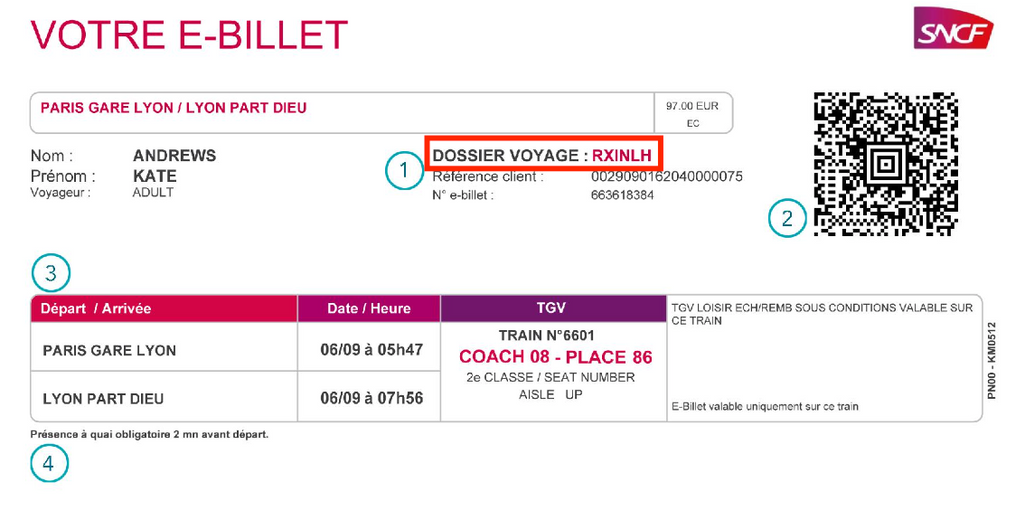
Example of an SNCF ticket. Source: RailEurope
The Indian Railways (IRCTC) also have PNRs, which store a variety of travel details, though it’s a 10-digit number instead.
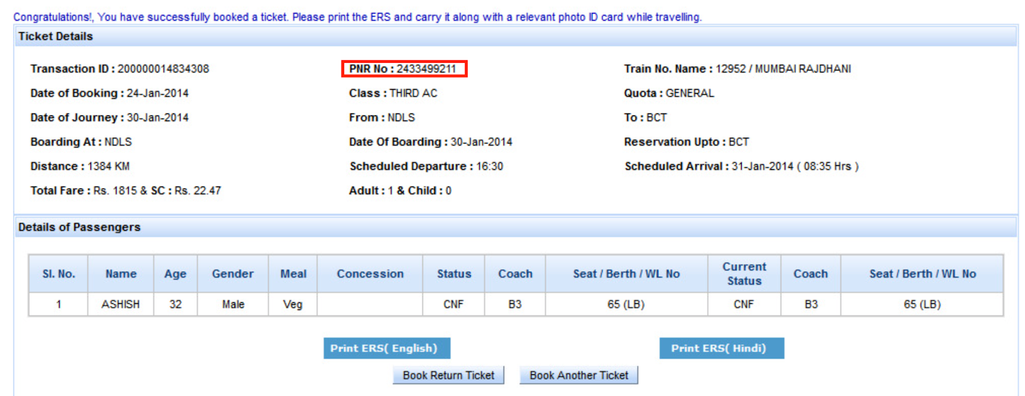
You can find your PNR number easily on the IRCTC confirmation. Source: IRCTC
Hope this helped clarify some common questions passengers have about PNRs. Now, we want to dive a bit deeper and explain what PNR actually contains.
PNR full form: Passenger name record data
Standards for the PNR were initially developed by the International Air Transport Association (IATA), the International Civil Aviation Organization (ICAO), and Airlines for America, previously known as the Air Transport Association of America (ATA). For those who want to better understand the role of IATA in the travel industry, we’ve prepared an educational video.
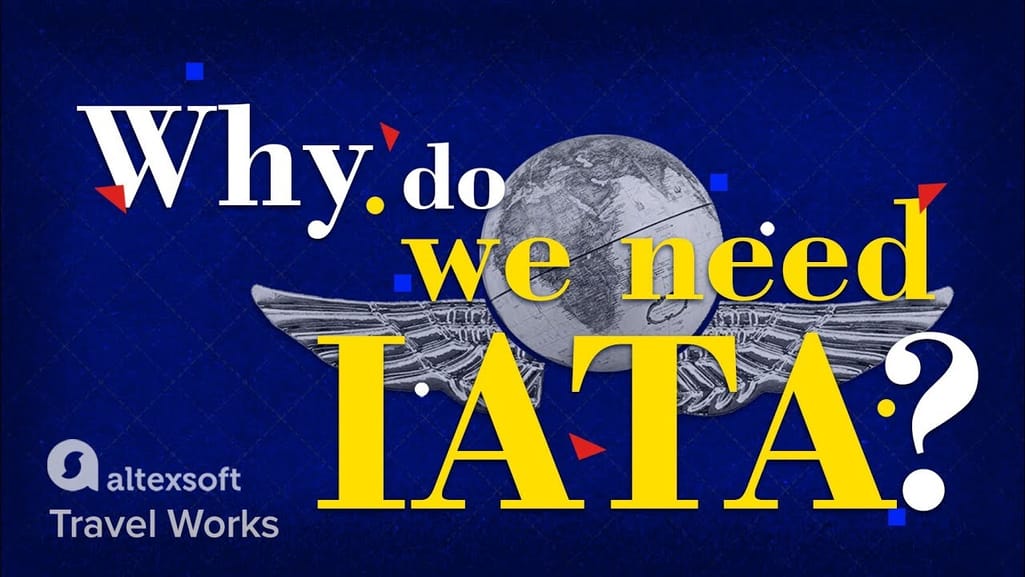

What is IATA, and how does it work?
However, neither IATA nor any other international organization dictates a universal format, exact number, and order of information pieces for PNRs. These bodies also don’t put restrictions on the number of characters to be used for each data element.
Due to the absence of unified rules, the file size and its content vary greatly from system to system and may reach as many as 999 data elements if you create a PNR in Amadeus. Regardless of the platform, much fewer components are used in practice, and only five of them are mandatory to comply with IATA/ICAO requirements.
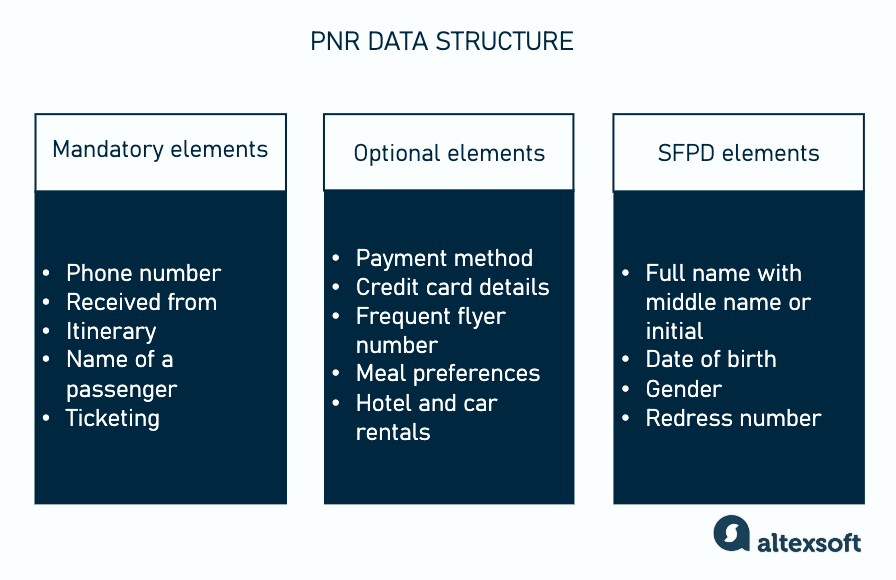
Key data components of a PNR file
Mandatory data elements
To easily recall the most essential data elements, Sabre suggests using the acronym PRINT, which stands for:
- phone either a traveler's or travel agent's to enable contact;
- received from field indicating the last person who has made changes in the PNR, typically a passenger or travel agent;
- itinerary that must include at least one segment of the journey;
- name of a passenger or passengers, containing the full first and last name (the middle name is not required); and
- ticketing specifying how and when a ticket is to be issued.
The mandatory elements can be arranged in any order and modified at any time after the booking is made. In the absence of at least one of them, it’s impossible to complete a reservation, create a PNR, and obtain a record locator.
Optional data elements
Mandatory parts contain essential trip details, describing where and when a particular passenger intends to fly. Optional components are added according to the commercial needs of airlines and may include
- additional itinerary segments that can be a flight, hotel reservation, car rental, etc.;
- payment method (cash, credit/debit card, or check);
- credit card number;
- passenger email address;
- frequent flyer number;
- travel agency name and address;
- fare and pricing details;
- restrictions that may apply to the ticket;
- age details relevant to the travel (for example, unaccompanied children or elderly people who need assistance);
- special service requests (SSRs) like meal or seating preferences;
- agency service fees;
- other remarks related to the trip; and
- historical changes to the PNR.
A payment method, also called a form of payment, is one of the most important optional elements since it’s mandatory to issue a ticket and complete the booking process. This information is added to the PNR file after a passenger pays for the flight.
In different CRSs and GDSs, the same data elements can be presented under different names and in a different order, split into two fields or, vice versa, grouped under one heading. This striking diversity hampers the effective evaluation and processing of data collected by airlines. So, when security bodies decided to systematically review PNRs as a part of counter-terrorism measures, they insisted on the implementation of a special field with a strict structure.
Secure flight passenger data and advance passenger information systems
In 2009, the US Transportation Security Administration (TSA) implemented the Secure Flight program to screen passengers before they board aircraft flying to, from, or over the United States. Under this mandate, PNRs of travelers making for the Land of Liberty must contain secure flight passenger data (SFPD) elements — such as:
- full name with the middle name or initial if it appears on the ID card, passport, driver’s license, or another valid identity document with the photo;
- date of birth;
- gender; and
- redress number issued by the (TSA) to facilitate identity checks. This unique number is particularly important if a passenger has a common name shared by many people or if he or she has already been misidentified in the past when crossing US borders.
The Secure Flight final rule obligates airlines to enter SFPD in the PNR and transmit it to the TSA at least 72 hours before the flight departure. If the bookings are created within 72 hours, carrier operators must gather and provide the information as soon as possible.
Then, the Secure Flight Program matches the SFPD portion against watchlists maintained by the Terrorist Screening Center. Based on the results, the passenger undergoes expedited, normal, or additional screening at the checkpoint or is denied boarding.
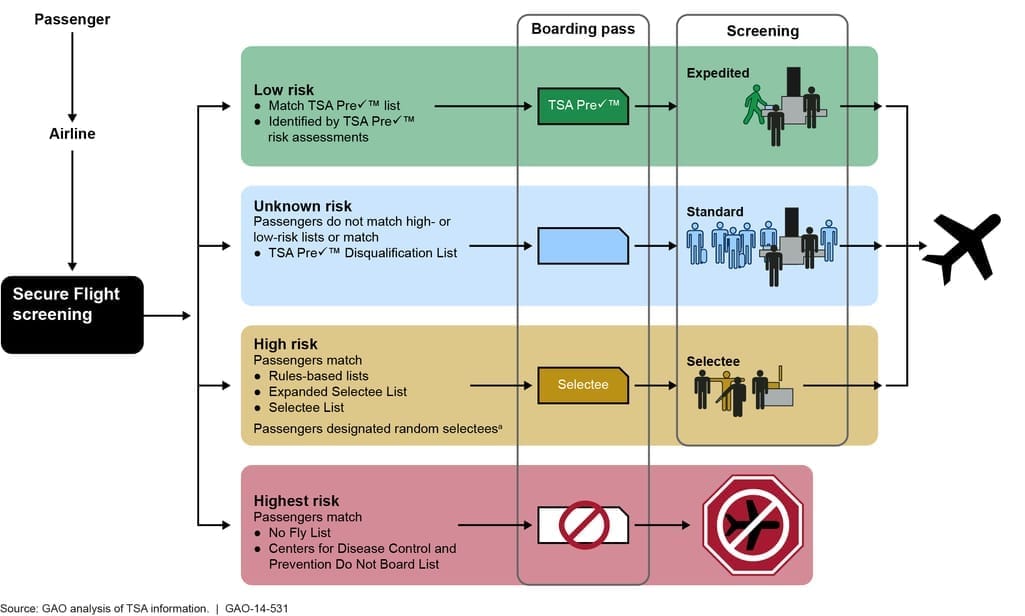
Besides that, the US and more than 60 other countries require airlines to collect advance passenger information (API) that includes data travelers have to reveal at the border control — passport details, citizenship, place of residence, and even the address of the first night spent in the country for travelers to the US.
Some of the API elements can be extracted from the PNR. Moreover, both are often regulated by the same documents. In the EU countries, the use of PNR and API data for crime and terrorism prevention is ruled by the PNR Directive issued in 2016. However, advance passenger information has nothing to do with the convenience of carriers and benefits security authorities rather than airlines.
PNR creation and lifecycle
PNR is an essential part of the flight booking process that precedes and enables ticketing.
Nobody can book a flight, pay for a ticket, and get on a plane without a PNR. In the most basic scenario, a PNR makes the following steps during its lifecycle.
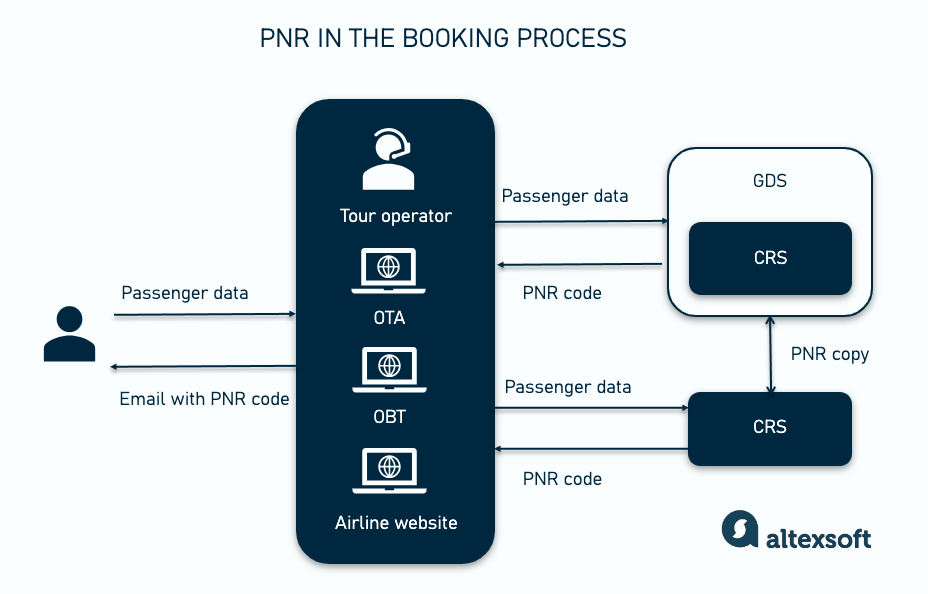
PNR as a part of the flight booking process.
1. Data collection. Essential trip data is gathered when an individual passenger or organization books a flight via a travel retailer — a carrier’s website, online travel agency (OTA), travel management company (TMC), tour operator, or other channels.
2. Data submission to the CRS. The reservation data is transmitted to the airline’s central reservation system (CRS). Many airlines don’t run their own CRS, but use ones based on one of the major global distribution systems (GDSs) — Amadeus, Sabre, or Travelport. Amadeus’ Altea and Sabre’s SabreSonic are the most popular CRSs on the market. You may learn more about the main GDSs from our dedicated video.
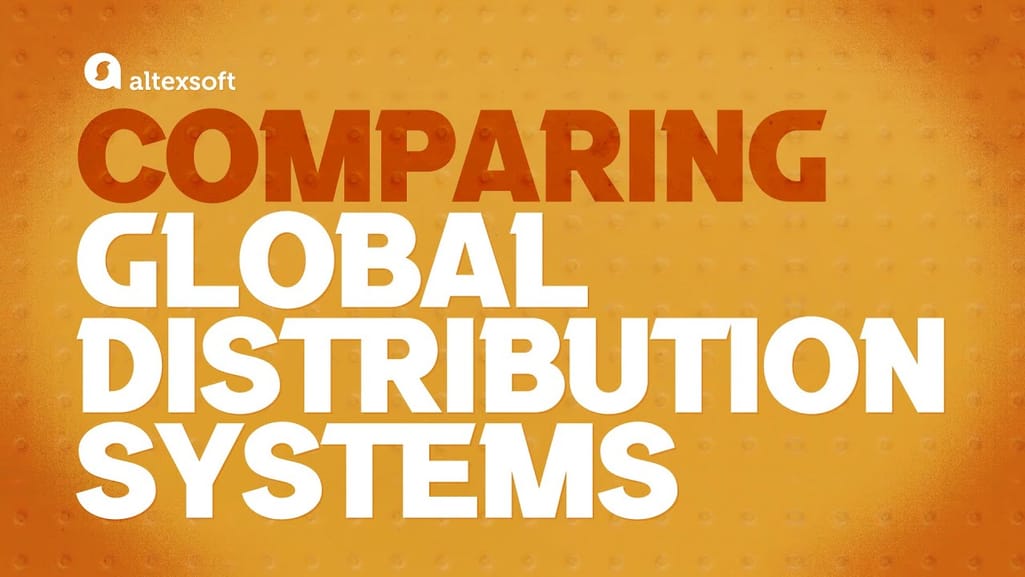

Amadeus vs Travelport vs Sabre: explaining main global distribution systems.
3. Initial PNR generation. A carrier’s operator or authorized travel agent logs into the CRS to build a PNR file with five mandatory elements.
4. Booking reference or PNR code assignment. The system generates a booking reference — a unique alphabetic or alphanumeric code assigned to the PNR file. It serves as a digital address of the document in the airline’s database.
5. Updates and addition of new details. If required, the agent or operator adds new data elements or makes changes to the record. Generally, the PNR is updated every time the reservation information is altered.
6. PNR synchronization. Whenever the flight includes multiple legs operated by different airlines using different CRSs, their corresponding PNRs need to be synchronized. We have a section further explaining this step in detail.
7. Booking confirmation. The travel retailer sends an e-mail with the PNR code (booking reference) to the passenger as a reservation confirmation. The airline ticket will be issued only after the passenger pays the fare.
8. Archiving. When the trip ends, the PNR is automatically archived. Usually, it happens within one to five days after the final segment of the itinerary is completed.
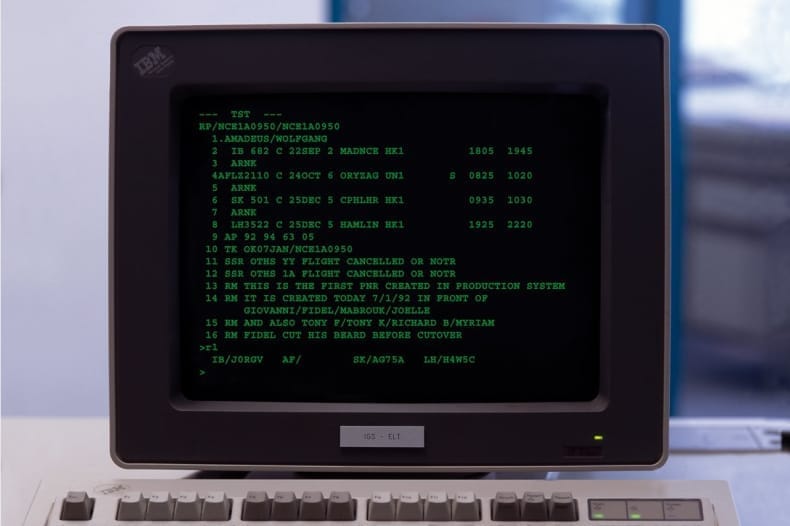
PNR in business travel booking. Passive segment, explained
Sometimes a booking is made outside of a GDS, say, when a travel manager at a company is creating a reservation in a separate system, such as an online booking tool (OBT).
In this case, the reservation might not automatically exist in the GDS that the travel management company (TMC) or travel agent uses to manage corporate bookings. When the booking originates outside the GDS, the information is transferred to the GDS through the use of passive segments.
A segment is a separate entry of a traveler’s itinerary recorded in the PNR. Each segment represents a specific service or reservation, such as
- a flight leg,
- a hotel booking,
- a car rental,
- any other travel-related service.
Segments allow organizing all parts of a trip into one comprehensive itinerary. So, a passive segment is like a note or a special instruction within the PNR, replicating the details of the external booking without actually sending booking requests to the airlines or service providers.
For example, if a travel manager books an air ticket directly on the airline’s corporate platform, the details can be manually or automatically entered into the GDS as passive segments. This ensures that the reservation is visible to the TMC, enabling them to manage the traveler’s itinerary, apply reporting and policy compliance tools, and provide 24/7 support.
Passive segments are essential for maintaining a complete and unified view of all travel activity, especially in corporate travel, where centralized data is crucial for cost management, duty of care, and reporting. However, it’s important to note that passive segments don’t always guarantee ticketing or reservation control – these actions typically remain with the external booking system.
Why airlines need PNR synchronization
The trip may contain multiple flights operated by different carriers. If they all use the same CRS based on a GDS, say, Amadeus Altea, they end up sharing a single PNR with just one record locator rather than creating multiple copies under different codes. But this is not always the case. When carriers involved in an interline flight use different CRSs, their PNRs need to be synchronized.
Here’s how this goes.
The initial CRS creates a synchronized PNR or Master Itinerary and sends copies to providers involved in the multileg flight. Each carrier manages its portion of the trip and saves the updated document in its database, identifying it with a separate record locator.
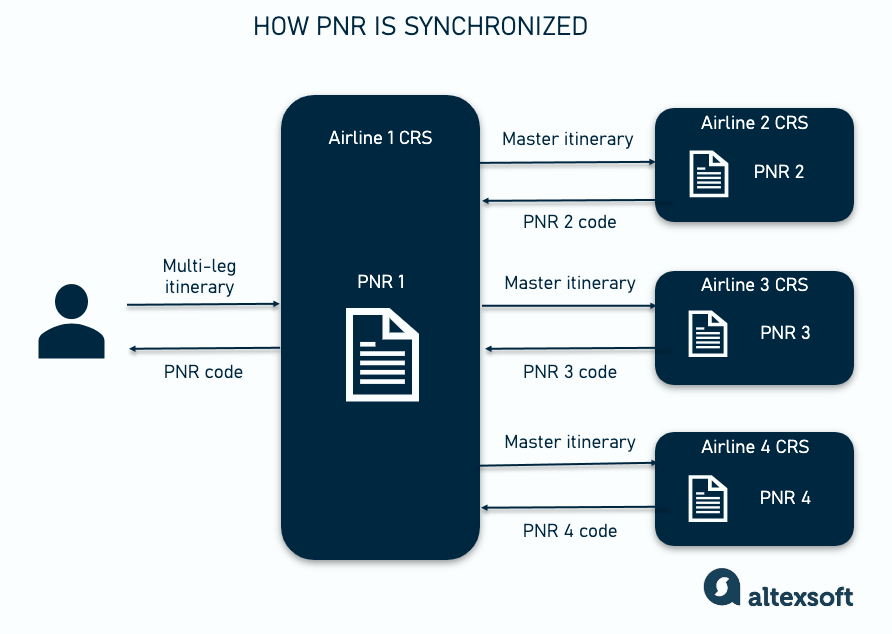
PNR synchronization, visualized
Eventually, all participants send record locators (PNR numbers) back to the synchronized PNR holder, connecting documents related to a particular itinerary and ensuring the exchange of updates. As a result, the same trip can get several PNR numbers in different reservation systems. A passenger receives a booking reference to the synchronized PNR that combines all parts of the trip.
Imagine a booking made through a GDS that includes segments on multiple airlines. For example:
- The passenger books a flight on Airline 1 through the GDS and this booking is stored in its host system, SabreSonic.
- The same booking also includes a connecting flight on Airline 2, which uses Amadeus Altea as its host system.
- The GDS, SabreSonic, and Altea each hold a PNR for the same booking.
To ensure accuracy, these PNRs must synchronize across all systems. If a change is made to the booking (such as updating a flight segment or adding a meal request), this change must be communicated to all systems involved. PNR synchronization is achieved using old-fashioned teletype messaging and protocols like EDIFACT.
Commercial use of PNR data and privacy concerns
While PNR data is extensively used to fight terrorism, its commercial application is limited by privacy concerns. Data-rich records capturing the habits and behavior patterns of passengers seem like a gold mine for training machine learning models that will help airlines with dynamic pricing, customer segmentation, and other complex tasks.
However, strict data privacy regulations hinder airlines from sharing information with research centers, start-ups, and IT vendors to create data-driven apps and extract valuable business insights. Say, the above-mentioned PNR Directive prohibits processing sensitive data like special meal requests or seat preferences. All PNRs must be depersonalized six months after the trip and deleted in five years.
In the US, PNR data obtained from commercial carriers is stored in the Automated Targeting System. Just as in the EU, PNRs are depersonalized after six months. In five years, records are moved to a dormant database where they remain available for another ten years — for security purposes only.
In truth, “PNRs cannot be deleted,“ Edward Hasbrouck, travel expert and author of the Practical Nomad book, argues. “Once created, they are archived and retained in the CRS/GDS, and can still be viewed, even if you never bought a ticket," he explains. "To cancel or delete a data element in a PNR means to move it from the live portion of the PNR to the permanent history portion. To cancel an entire PNR means to move it from active storage to archival storage.”
So, PNR data accumulated over the years can eventually be used — by criminals, by government bodies, or on a good day by commercial structures.
The future of PNR: One Order
The future of PNRs is likely to be engineered by ONE Order — an extension of IATA’s New Distribution Capability (NDC) program facilitating the direct distribution of travel products and smooth data exchange among different platforms.
Currently, airlines have to deal with three types of travel records — PNRs focusing on itinerary details, e-tickets capturing payment information, and electronic miscellaneous documents (EMDs) with the list of purchased ancillaries. These documents are created in the legacy EDIFACT format used across the airline industry. Moreover, they are stored in different back-office systems, which adds complexity and increases expenses for carriers.
In a ONE Order world, all travel data in question will be captured in a single XML file by a single system. This will make things far easier for all providers and travel agents.
If you want to learn more, watch our video detailing how online booking unfolds offscreen.
